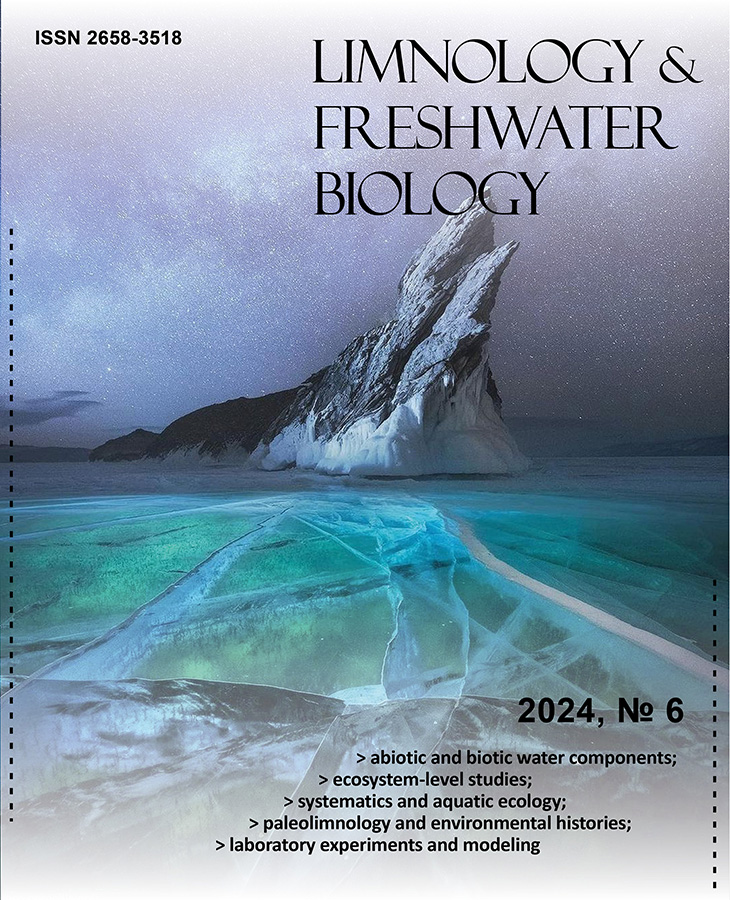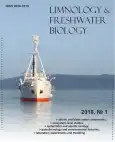Aerosol in the atmosphere of the Baikal region: history and contemporary researches
- Authors: Golobokova L.P.1, Khodzher T.V.1, Obolkin V.A.1, Potemkin V.L.1, Khuriganova O.I.1, Onischuk N.A.1
-
Affiliations:
- Limnological Institute, Siberian Branch of the Russian Academy of Sciences
- Issue: No 1 (2018)
- Pages: 49-57
- Section: Articles
- URL: https://journals.rcsi.science/2658-3518/article/view/286196
- DOI: https://doi.org/10.31951/2658-3518-2018-A-1-49
- ID: 286196
Cite item
Full Text
Abstract
The results of long-term studies (1995-2017) of the physical properties and chemical composition of atmospheric aerosol in the Baikal region are considered. These studies are important for understanding the role of the atmosphere in the formation of the chemical composition and quality of the waters of Baikal and its inflows. Over the past two decades, Limnological Institute SB RAS (Irkutsk, Russia) have conducted various joint studies of the characteristics of atmospheric aerosol with Russian and foreign groups. The chemical composition, biological component, size distribution, spatial distribution and aerosol sources over the lake were investigated. The interannual variability of the main chemical compounds in the aerosol was estimated. So, over the period studied, there was a gradual decrease observed in the concentrations of the main ions in the aerosol composition: in Irkutsk by 2.1 times, Listvyanka - by 4.0 times, at the background site of Mondy - by 3.5 times. In addition to quantitative changes, there is a change in the ratio of the main ions in the aerosol at Listvyanka site (south-west coast of Lake Baikal) and at the background site of Mondy. Upon condition of no external influences the content of the main ions in the aerosol on the surface layer of Lake Baikal is significantly lower (0.33-5.2 μg·m-3) than during of extreme conditions (2.2-5.2 μg·m-3). Forest fires near Baikal cause an increase of the concentrations of Na+, K+, NH4+, Cl-, and NO3- ions in Baikal aerosols. Components of soil-erosion origin (Al, Fe, Zn, Cr, Ba) dominate in the elemental composition of the aerosol. Their concentration increases during forest fires up to 1.4 - 6 times at average. The flows of sulfur and nitrogen, the main acidifying components, differ in different years of observations both at the monitoring sites and over the surface of Lake Baikal.
Keywords
About the authors
L. P. Golobokova
Limnological Institute, Siberian Branch of the Russian Academy of Sciences
Author for correspondence.
Email: lg@lin.irk.ru
ORCID iD: 0000-0002-4960-8135
Russian Federation, 3, Ulan-Batorskaya Str., Irkutsk, 664033
T. V. Khodzher
Limnological Institute, Siberian Branch of the Russian Academy of Sciences
Email: lg@lin.irk.ru
Russian Federation, 3, Ulan-Batorskaya Str., Irkutsk, 664033
V. A. Obolkin
Limnological Institute, Siberian Branch of the Russian Academy of Sciences
Email: lg@lin.irk.ru
Russian Federation, 3, Ulan-Batorskaya Str., Irkutsk, 664033
V. L. Potemkin
Limnological Institute, Siberian Branch of the Russian Academy of Sciences
Email: lg@lin.irk.ru
Russian Federation, 3, Ulan-Batorskaya Str., Irkutsk, 664033
O. I. Khuriganova
Limnological Institute, Siberian Branch of the Russian Academy of Sciences
Email: lg@lin.irk.ru
Russian Federation, 3, Ulan-Batorskaya Str., Irkutsk, 664033
N. A. Onischuk
Limnological Institute, Siberian Branch of the Russian Academy of Sciences
Email: lg@lin.irk.ru
Russian Federation, 3, Ulan-Batorskaya Str., Irkutsk, 664033
References
- Anokhin Yu. A., Kokorin A.O., Prokhorova T.A. et al. 1991. Aerosol pollution of atmosphere above Lake Baikal and effect of industrial sources (1991). In: Israel Yu.A., Anokhin Yu.A. (Eds.), Monitoring sostoyaniya ozera Baikal [Monitoring of Lake Baikal state] Leningrad: Hydrometeoizdat, pp. 44–50. (in Russian)
- Balin Yu.S., Klemasheva M.G., Kokhanenko G.P. et al. 2016. Lidar study of the vertical structure of aerosol fields in the atmosphere over Lake Baikal during forest fires. Atmospheric and oceanic optics 29: 689–693. (in Russian)
- Belan B.D., Zuev V.E., Kovalevsky V.K. et al. 1996. Comprehensive assessment of the state of the air basin over the Baikal and Lake Baikal. Russian Meteorology and Hydrology 10: 39-50. (in Russian)
- BSM (Brief Statistical Manual). 2016. Irkutsk Regional Brief Statistical Manual. [http://irkutskstat.gks.ru/wps/wcm/connect/rosstat_ts/irkutskstat/ru/publications/official_publications/electronic_versions. Last Access: 07 October 2017]
- EANET (Acid Deposition Monitoring Network in East Asia). 1998-2017. Report of the Inter-Laboratory Comparison Project. [http://www.eanet.asia/product/index.html. Last Access: 29 October 2018]
- EANET (Acid Deposition Monitoring Network in East Asia). 2000. Report on the Acid Deposition Monitoring of EANET during the Preparatory Phase. [http://www.eanet.asia/site/index.html. Last Access: 29 October 2018]
- GAW (Global Atmosphere Watch). 2004. Manual for the gaw precipitation chemistry programme. WMO-GAW Report No. 160. In: Allan M.A. (Ed.), Precipitation chemistry [manual. http://qasac-americas.org. Last Access: 01 November 2018]
- Golobokova L.P., Kobeleva N.A., Makukhin V.L. et al. 2002. Some Results of Experimental Observations and Mathematical Simulation of Distribution of Acidifying Atmospheric Admixtures in the Region of Southern Baikal. Chemistry for Sustainable Development 10: 575–583.
- Golobokova L.P. 2004. Development and application of techniques for studies of chemical composition of gaseous impurities and atmospheric aerosol (exemplified by Baikal Natural Territory). Cand. Sc. Dissertation, Institute for Water and Environmental Problems SB RAS, Barnaul, Russia. (in Russian)
- Golobokova L.P., Latysheva I.V., Mordvinov V.I. et al. 2005. Peculiarities in the chemical composition of atmospheric aerosol against the background of extreme weather conditions in Southern Siberia. Atmospheric and oceanic optics 18: 616–620
- Golobokova L.P., Latysheva I.V., Ivanova A.S. et al. 2006. Mesoclimatic and aerosynoptic conditions of ionic composition formation of atmospheric aerosol in high-mountain regions of Eastern Sayans. Geography and Natural Resources 2: 83-88
- Golobokova L.P., Khodzher T.A., Khodzher T.V. 2007. Current estimate of dry surface deposition of chemical substances in different regions of Asian territory of Russia. Atmospheric and oceanic optics 20: 470-473
- Golobokova L.P., Filippova U.G., Marinaite I.I. et al. 2011. Chemical composition of atmospheric aerosol above the Lake Baikal area. Atmospheric and oceanic optics 24: 236–241. (in Russian)
- Golobokova L. P., Khodzher T.V., Obolkin V.A. et al. 2018. Long-term investigations of atmospheric aerosol and gaseous impurities in Southern Pribaikalye, East Siberia (Russia). International Journal of Environmental Sciences and Natural Resources 10: 555786. doi: 10.19080/IJESNR.2018.10.555786
- Khodzher T.V. 1983. Chemical composition of atmospheric precipitation. Ecology of Southern Baikal. Irkutsk, pp. 44–50. (in Russian)
- Khodzher T.V., Potemkin V.L., Obolkin V.A. 1994. Chemical composition of aerosol and trace gases in the atmosphere over Lake Baykal. Atmospheric and oceanic optics 7: 566–569.
- Khodzher T.V., Golobokova L.P., Obolkin et al. 1997a. Diurnal and seasonal variability of the atmospheric aerosol ion composition in the south of East Siberia. Atmospheric and oceanic optics 10: 403-406
- Khodzher T.V., Obolkin V.F., Potemkin, V.L. et al. 1997b. Seasonal variability of the elemental composition of atmospheric aerosols above Lake Baikal. Chemistry for Sustainable Development 5: 547–561. (in Russian)
- Khodzher T.V. 2005. Study of composition of atmospheric precipitation and its effect on ecosystem of the Baikal Natural Territory. Dr. Sc. Dissertation, V.B. Sochava Institute of Geography SB RAS, Irkutsk, Russia. (in Russian)
- Koutsenogii P.K., Bufetov N.S., Drosdova V.I. et al. 1993. Ion composition of atmospheric aerosol near Lake Baikal. Atmospheric Environment 27A: 1629–1633.
- Lowenthal D., Rahn K. 1985. Regional sources of pollution aerosol at Barrow, Alaska during winter 1979–80, as deduced from elemental tracers. Atmospheric Environment 19: 2011–2024.
- Mattias-Maser S., Obolkin V., Khodzher T. et al. 2000. Seasonal variation of primary biological aerosol particles in the remote continental region of Lake Baikal, Siberia. Atmospheric Environment 34: 3805–3811. doi: 10.1016/S1352-2310(00)00139-4
- Obolkin V.A., Khodzher T.V. 1990. Annual input of sulfate and mineral nitrogen from atmosphere in the area of Lake Baikal. Russian Meteorology and Hydrology 7: 71–76. (in Russian)
- Obolkin V.F., Potemkin V.L., Khodzher T.V. 1994. Elemental composition and main sources of atmospheric aerosol of Southern Baikal. Geography and Natural Resource 3: 75–81.
- Obolkin V., Khodzher T., Sorokovikova L. et al. 2016. Effect of long-range transport of sulphur and nitrogen oxides from large coal power plants on acidification of river waters in the Baikal region, East Siberia. International Journal of Environmental Studies 73: 452–461. doi: 10.1080/00207233.2016.1165481
- Obolkin V.A., Potemkin V.L., Makukhin V.L. et al. 2017. Far transfer of trails, ejected by regional electric power stations to the South Baikal water area. Atmospheric and Oceanic Optic 30: 360–365. doi: 10.1134/S1024856017040078
- Overview of the state and pollution of the environment in the Russian Federation for 2016. 2017. Federal Service for Hydrometeorology and Environmental Monitoring (Roshydromet), Moscow, SBN 978-5-904131-48-7.
- Paramonov S., Ryaboshapko A., Gromov S. et al. 1999. Sulfur and nitrogen compounds in air and precipitation over the former Soviet Union in 1980-1995. Report CM-95. International Meteorolodgical Institute, Stockgolm.
- Rahn K.A. 1976. The chemical composition of the atmospheric aerosol. Technical Report, University of Rhode, Island.
- Recommendation on peat fire extinguishing on dried bogs. Experience of volunteer forest firemen. 2015. Moscow: Cityprint. (in Russian)
- Sorokovikova L.M., Netsvetaeva O.G., Tomberg I.V. et al. 2004. Effect of atmospheric precipitation on the chemical composition of river waters in the South Baikal region. Atmospheric and oceanic optics 17: 373–377.
- State Reports «On State and Protection of the Irkutsk Region Environment for 1999». 2000. State Environmental Protection Committee of the Irkutsk Region. Irkutsk, 319 p. (in Russian)
- State Reports «On State and Protection of the Irkutsk Region Environment». 2008-2017. [http://irkobl.ru/sites/ecology/picture, Last Access: 29 October 2018]. (in Russian)
- State Reports «On State and Protection of the Irkutsk Region Environment». 2013. [http://irkobl.ru/sites/ecology/picture. Last Access: 28 October 2018]. (in Russian)
- Swietlicki E. 1989. European source region identification of long range transported ambient aerosol based on PIXE analysis and related techniques. Lund, Sweden.
- Van Maldren H., van Griken R., Khodzher T.V. et al. 1994. Analysis of individual aerosol particles in Siberian region. Provisional results. Atmospheric and oceanic optics 7: 622–626.
- Van Malderen H., Van Grieken R., Khodzher T.V. et al. 1996. Composition of individual aerosol particles above Lake Baikal, Siberia. Atmospheric Environment 30: 1453–1465.
- Vetrov V.A., Klimashevskaya Z.A. 1985. Monitoring of pollution of the land surface and Lake Baikal with inorganic components of emissions from Baikalsk Pulp and Paper Plant. In.: Israel Yu.A. (Ed.), Improvement of regional monitoring of Lake Baikal state. Leningrad: Hydrometeoizdat. (in Russian)
Supplementary files










